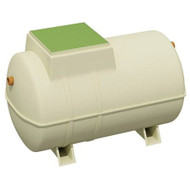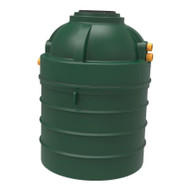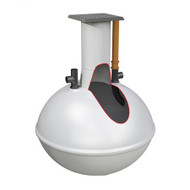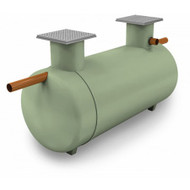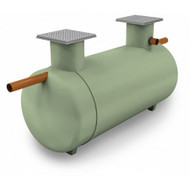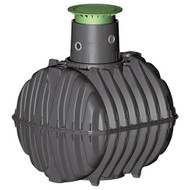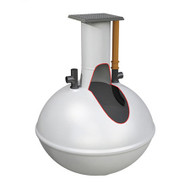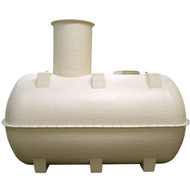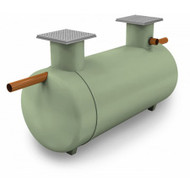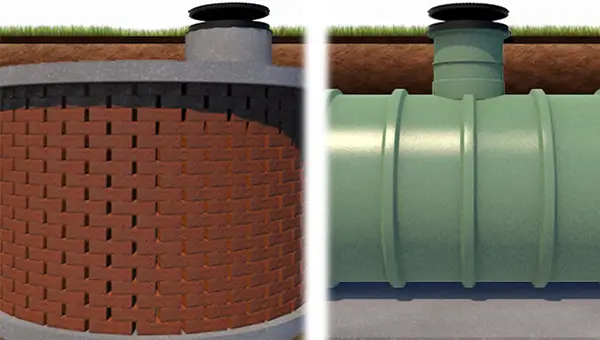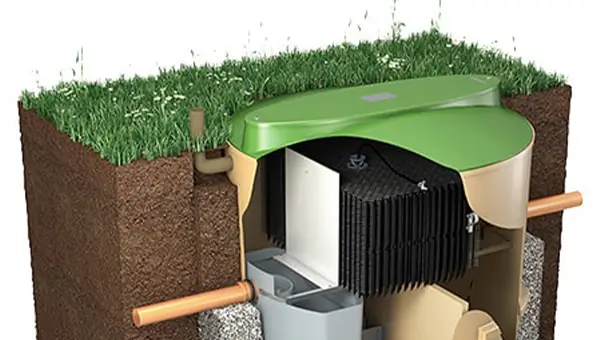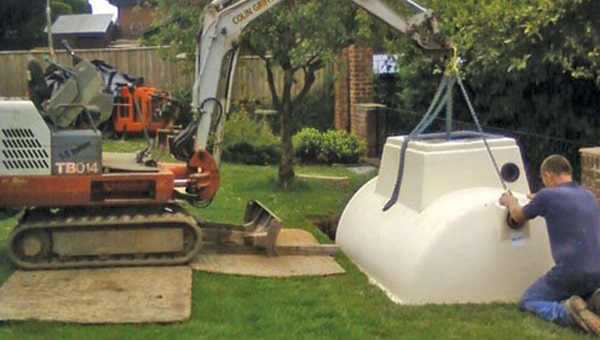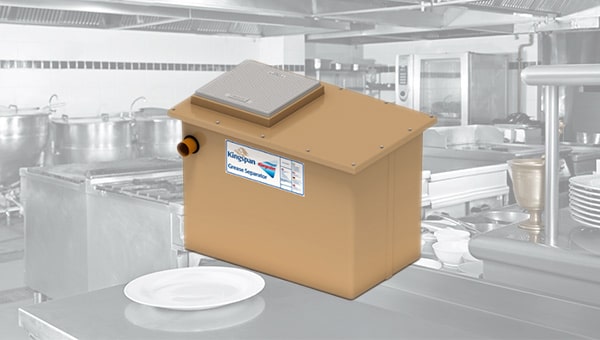
Off mains drainage options are vital for properties that can’t connect to the main sewer system, but they do take a bit of thought and planning to set up safely and correctly. Making sure that you understand all of the legal requirements and responsibilities, check your ground is suitable for the appropriate discharge option, and know how to choose the best type of tank are things you should do before investing in an off-mains system.
If you are buying a house with an off-mains system that is relatively new, the proper planning should have already been taken care of (though it’s always advisable to ask questions about it), in which case your main priority should be to familiarise yourself with the proper operation and maintenance of it insead. Check out our “How to operate and maintain a septic tank drainage system” article for advice on this.
But what if your property has an old septic tank that is in need of replacing, or you decide you’ve had enough of being connected to the mains sewer system like everyone else and want to break out on your own? You may then be wondering if it is a project you can take on yourself? In this article, we intend to try and help you answer that question. Let’s start by looking at the rules and regulations surrounding septic tanks.
Note: This article assumes prior understanding of all the off-mains solutions available to you and that you have chosen a septic tank because it is the most suitable one for your property. If you are unsure about this, we strongly recommend first taking a look at our guide to off-mains drainage.
Understanding the Legislation
The legal aspects of installing an off mains drainage system can be quite daunting to deal with. There are rules and regulations for everything from the type of tank that is appropriate for a property, to where it can be installed, where it can discharge to, and what kind of ground conditions are acceptable.
Please Note: This article focuses on the rules and regulations for installing septic tanks in England. Different rules exist for installations in Northern Ireland, Scotland and Wales, details of which can be found via their respective links.
For septic tanks, it is especially important to be aware of the most current legislation, as there have been significant changes to where they can discharge too. As of 1st January 2020 septic tanks are no longer allowed to discharge to a watercourse as they provide very little treatment to the waste water. Your only options now are as follows:
- Connect to a mains sewer, if at all possible.
- Install a sewage treatment plant instead if you still want to discharge to a watercourse.
- Install a suitable drainage field for the septic tank to discharge into.
Please Note: All references in this article to either “drainage fields” or “soakaways” refers specifically to those designed for wastewater only. Surface water soakaways, soakaway pits, soakaway crates or tunnels must NEVER be used for the discharge of septic tank effluent.
Complying with all of the regulations is of paramount importance, both for the environment and for you as the property owner. Local authorities and/or relevant environment agencies have the power to test any off-mains/private drainage system in their jurisdiction and take legal action against the owner if found to be non-compliant.
Do not be tempted to install a septic tank as a cheap option without the necessary consent. It could prove a very costly mistake. Make sure you are fully aware of all the regulations that could affect your installation, and operation, of a septic tank system.
The best place to start is in fully reviewing the General Binding Rules. This should govern the planning of your system and will inform whether a septic tank will be suitable for your property.
The following points offer a quick overview of the main rules for septic tanks:
- Tank must be rated to BS EN 12566-1 standards.
- It must be installed at least 7 metres away from any habitable building.
- It must be installed within 30 metres of an access point for desludging services.
- A septic tank can only service the sewage and wastewater needs of a limited number of people – please check with your national environment authority for advice.
- Installation is not permitted in Zone 1 of a Groundwater Source Protection Zone.
- They can only discharge into a soakaway/drainage field which complies with Building Regulations or BS 6297.
- Discharge must not be directly into a watercourse (stream, lake, etc.).
- Consent to discharge must be applied for from the Environment Agency (England & Wales), SEPA (Scotland) or DAERA (Northern Ireland).
Ideally, if the conditions of the General Binding Rules are met, your septic tank should be able to discharge into a drainage field/soakaway. A drainage field (or soakaway system) is made up of a series of perforated/slotted pipes that provide the main stage of treatment for the discharged waste from a septic tank. However, installing a drainage field does come with its own set of additional rules.
- No part of the drainage field should be within 2 metres of a neighbouring boundary
- It should be at least 10 metres from any watercourse
- It should be at least 15 metres from any building
- It should be at least 50 metres from a water supply (e.g. well or borehole)
- No access roads, driveways or paved areas should be located within the area
If your property does not meet the requirements for a drainage field, either due to poor ground results (see site survey section) or not enough space, you may want to consider installing a sewage treatment plant instead as this could give you the alternative option of discharging to a watercourse. Check out our sewage treatment plant installation guide to compare the steps involved.
Sewage Treatment Plants
In summary, these are just the main points and we stress that you should fully understand the legislation and implications of installing a septic tank, and always consult professional advice if you're unsure. If, however, you've absorbed relevant information from the General Binding Rules like good soil absorbs discharged effluent, and you're confident your system is within compliance, the next step is to perform a site survey.
Conduct a Site Survey
In order to buy and install the most suitable septic tank system for your property, you need to first evaluate the area of installation, in order to determine the conditions that will affect your choice. The best way to do this is to ask the following questions.
Can my property connect to the mains sewerage system?
The first thing to check is whether any part of your property is within 30 metres of a public sewer. If it is, you will not be allowed to install your septic tank or drainage field unless you obtain permission to discharge to an alternate system from the Environment Agency. Typically, however, they will not permit the use of a private system if a public one is available, unless a very good reason is given - such as the connection route to the main sewer being obstructed. To find out if there is a public sewer near your property, contact your local water authority.
Will my septic tank system comply with the General Binding Rules?
The next thing to do is to check that your proposed system will comply with the General Binding Rules, as mentioned in step 1. If, for any reason, it doesn’t, you’ll again need to apply to your national environment agency for consent to discharge. This could be the case in England if, for example, your drainage field would be within 500 metres of any:
- Special areas of conservation
- Special protection areas
- Ramsar sites
- Biological sites of special scientific interest
- Freshwater pearl mussel population
- Protected shellfish water
- Designated bathing water
How to meet the general binding rules if your septic tank or small sewage treatment plant releases (discharges) waste water to the ground.
You would also need a permit if the new discharge would be in or within:
- 200 metres of an aquatic local nature reserve
- 50 metres of a chalk river or aquatic local wildlife site
Unless you are 100% certain that your system would meet these criteria it is highly recommended you contact either JDP’s technical team or your national environment agency directly, to check if you’re in or near a designated sensitive area and to find out if you need a permit.
Will I need Planning Permission to install my Septic Tank?
You must always get planning permission and building regulations approval for all septic tank installations. Make sure you do this before you go any further, as failure to comply with, or acquire any one of these may prevent your installation all together. Assuming that you have done all of these legal checks, and that your property is indeed suitable for a private sewage system, you can then move on to conducting the actual site survey
How do I perform a septic tank site survey?
Before you can start planning your system, you’ll need to do all of the following:
- Conduct a Groundwater Source Protection Zone Search - to check your property isn’t in a restricted groundwater protection area
- Conduct Trial Site Assessment Hole Test - to determine the water table level beneath your property
- Conduct Percolation Tests - to check that the ground is suitable for a drainage field to be installed
A Trial Site Assessment Hole Test can be done by digging a 1m2 trial hole to a depth of at least 1.5m below the invert level of the proposed drainage field pipework. Any water pooling into this hole from the surrounding soil will indicate the position of the standing groundwater table. As long as the groundwater doesn't rise to within 1m of the invert level, your proposed drainage field will pass this test. Don’t forget, however, that the groundwater levels will be different at different times of the year, so be sure to take that into account.
For advice on how to perform a percolation test, check out our dedicated article or have a watch of our companion video to see how it's done.
The last item on your site survey “to-do list”, is to check that the proposed location of your tank will comply with the general binding rules. Assuming you have read the rules and understand the restrictions, this should be as easy as measuring up your garden to make sure you can fit the tank on your property without it breaking the rules.
If all the above come back with good results you can then move on to the design stage of your system. However, if any of the results aren't good, your septic tank journey may have to end here. Without the ability to safely discharge the effluent from your system, your only other option would be to install a cesspool that will store your sewage and wastewater for regular removal by a registered waste company. Check out our cesspools article for more on this.
Design the system
The results from your site survey will all have an impact on the design of your system. From how deep your tank can be installed and where it can be located, to the size of the drainage field you will require. Now comes the time to start looking for a septic tank that fits all the criteria.
Before you go and check out our comprehensive catalogue of septic tanks however, there are a few more calculations to make and things to consider to help you find the right one. These include:
- Sizing the tank to your needs.
- Choosing the right tank.
- Sizing the drainage field.
How do I size a septic tank?
Sizing a septic tank can be a bit tricky, as they are usually categorised firstly by their capacity and then by the number of people they can service. You need to be able to determine the minimum population size of your property (which calculates the property’s potential population rather than just the number of people currently living there) as well as the volume of sewage and wastewater that your property is likely to produce, as this will help you work out the capacity needed.
Undersizing or oversizing the system you need can both cause costly problems in the future (especially if you ever come to sell your property). For these reasons, we would strongly recommend that you read our dedicated how to size a septic tank or sewage treatment plant article to ensure you are selecting the right capacity for your property.
How do you choose the right septic tank?
It's quite difficult to offer advice on how to choose the best septic tank without knowing specific details of the project. However, we believe the following factors are all worth keeping in mind when making your choice.
| Septic Tank Choice Factors | ||
|---|---|---|
| Choice Factor | Why it is important | Where to get the information |
| Installation Ease & Cost: | The following factors can all have an effect on the scale and cost of the installation. | For all installation related factors, you will need to check the relevant installation guides and technical drawings (provided by supplier/manufacturer) and/or consult the building regulations. |
| Excavation Size | Having the required space is important. The larger the tank, the larger the excavation and the greater the cost. | |
| Excavation Depth | A deep dig tank can significantly increase the cost of installation, but will generally take up less horizontal space under the property. A shallow dig tank can reduce the cost and be more suitable in higher water table areas, but will also take up more horizontal space. | |
| Sitting the Tank | Will the selected tank fit within your planned area of install while remaining compliant with current legislation? | |
| Pipe Invert Levels | This is important to know if you are retrofitting a new tank and plan to use existing inlet and outlet pipework. | |
| Aesthetic Aspects: | There will always be some visual indication of your tank, despite it being buried under ground. If you like to keep an immaculately landscaped garden, for example, the following could prove important to your decision. | Check product descriptions for details on these factors, or contact the supplier/manufacturer to find out more. |
| Cover Type & Size | Covers vary largely between septic tanks, from large, visually unappealing lumps in your garden, to small, unobtrusive discs that blend in with the grass. They can also be made from different materials, often influenced by the type of loading they will need to withstand. | |
| Operation & Maintenance: | When buying your tank, thought should be given to factors that could influence its lifespan and maintenance needs, such as: | |
| Tank Material | GRP, HDPE, PP, Concrete? Septic tanks can be made out of a number of different materials, all with their own plus and minus points. GRP is a fairly common choice, but care should be taken during transportation and installation as these tanks are easily damaged. HDPE is incredibly strong, but can bend slightly over time without reinforcement. Concrete is an excellent material, but has become less common now due to much higher install costs and maintenance difficulties. The indicated lifespan and offered warranty on the tank are the important things to check. Sometimes when you buy cheap, you end up buying twice. | The material of the tank should be listed in the product descriptions, but you may need to contact the supplier/manufacturer for warranty/guarantee periods. |
| Alarm System | All septic tanks must have an alarm according to building regulations. However, the type of alarm can vary from wired control panels to wireless receivers. Perhaps not a high priority choice, but worth considering if you have a preference over where you’d like your alarm to be located. | Ask the supplier/manufacturer for specific details. |
| Servicing & Desludging Periods | It is highly recommended to get your septic tank desludged at least once a year. Some models may promise longer intervals, but make sure you research the conditions needed for this to be achievable. | Contact Supplier/manufacturer. |
| Tank Warranty | If a septic tank cracks or leaks, it’s not difficult to imagine the mess you will be in...and a costly one at that. Generally speaking, a tank will not crack or bend within the first 12 months of install. If they are going to fail, it will be once the ground has fully settled, which could take a few years. The longer the warranty, the more confidence the manufacturer has in the quality of their product, and the more peace of mind you will have. We’d recommend looking for a minimum warranty of at least 5 years. | Contact Supplier/manufacturer if the warranty period is not stated in the product description. |
Septic Tanks
How do you size a drainage field/soakaway?
Septic drainage fields usually consist of an arrangement of trenches, which contain perforated pipes and gravel, sited beneath a soft landscaped area such as a lawn. Determining the size required for your system will depend on both the size of your property/number occupants and the results of your percolation tests. Check out our dedicated article sizing a septic drainage field for a guide to the calculations involved.
And that’s it for this article. We hope it has been informative and helped to answer most of your questions regarding septic tank regulations and planning. If you feel ready to choose your tank and get it installed, we offer a large range of suitable septic tanks for various population sizes that you can check out, along with a handy septic tank installation guide to help you with the installation.
If you have any questions, or need any further advice regarding septic tanks or other off-mains sewage systems, please do not hesitate to contact us. Our technical team is always on hand to help with all of your drainage needs.

